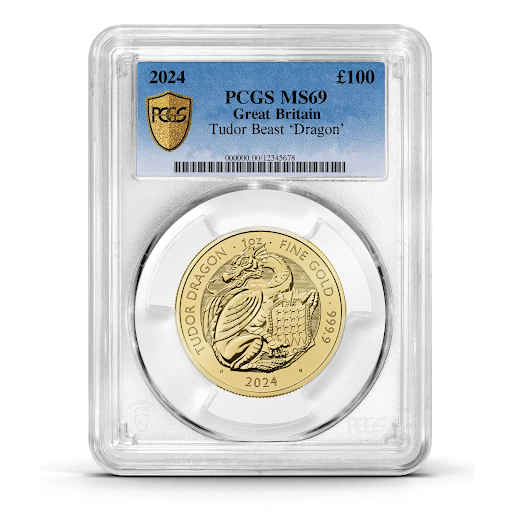When it comes to investing in coins, one crucial factor that dramatically affects the value of your portfolio is coin grading. Whether you’re a novice investor or an experienced numismatist, understanding the distinction between PCGS-certified and non-PCGS-certified coins can significantly influence the quality, marketability, and long-term value of your investment. Additionally, it’s essential to consider reputable grading companies when buying or selling coins, as this can play a vital role in ensuring that you acquire high-quality assets and receive fair market value. By focusing on well-certified coins, investors can enhance the potential for appreciation while minimizing risks.
What is Coin Grading?
Coin grading refers to evaluating a coin’s physical condition, quality, and authenticity. Coins are assessed based on wear, surface preservation, strike quality, and eye appeal. This grading is then expressed on the Sheldon Scale, which ranges from 1 to 70, with 1 being a severely worn coin and 70 representing a perfect coin.
Grading is crucial for collectors and investors because it provides a consistent and trusted benchmark for evaluating the value of coins. The top grading service in the industry is the Professional Coin Grading Service (PCGS). In this article, we’ll focus on certified coins, their benefits, and how they compare to non-certified coins.
What is PCGS?
The Professional Coin Grading Service (PCGS), founded in 1986, is among the numismatic industry’s most respected and widely recognised grading companies. Known for its stringent grading standards, PCGS evaluates coins through a rigorous process by highly trained experts.
Once certified, each coin is encapsulated in a tamper-proof holder, commonly called “slabbing,” and includes a label that details the coin’s grade, year, denomination, and mint mark. This encapsulation process protects the coin and ensures the grade remains intact, providing long-term confidence to collectors.
Benefits of PCGS Certified Coins
The value of purchasing PCGS-certified coins over non-certified or independently certified coins is evident in several key areas:
-
Credibility and Trust
One of the most significant advantages of PCGS-certified coins is the credibility that comes with a trusted name in coin grading. PCGS’s reputation for strict, consistent grading standards offers collectors confidence in the coin’s authenticity and condition. Non-PCGS-certified coins, particularly those certified by less-known services, may lack this level of reliability. Inconsistent grading standards and the absence of uniformity can mean that a coin given a specific grade by one service may not meet the same standard elsewhere. They provide peace of mind because their grades are recognised and trusted globally.
-
Enhanced Market Value
PCGS-certified coins generally command a premium in the marketplace. Collectors and investors are often willing to pay more for coins professionally certified by a reputable company. These coins have undergone strict evaluations, and their grading is universally recognised.Additionally, we recommend grading coins that are limited edition or have limited production runs. These coins often experience high demand due to their scarcity, making professional grading essential for preserving their value and ensuring authenticity. Grading adds an extra layer of confidence, making such coins more attractive to collectors and investors alike.In contrast, non-certified or raw coins often sell for less because of the uncertainty surrounding their condition, grade, or authenticity. Certified coins have a more substantial market presence and predictable resale value, making them a preferred choice for serious collectors.
-
Protection from Counterfeiting
Counterfeiting is a major issue in the world of coin collecting. One advantage of owning these coins is the extra layer of protection against fakes. Each coin certified is placed in a secure, tamper-proof holder that includes security features to verify its authenticity. Without the backing of a trusted grading company like PCGS, non-certified coins pose a higher risk of counterfeiting. As a result, collectors may be wary of purchasing non-certified coins due to their lack of authentication and certification.
-
Long-Term Preservation
PCGS-certified coins are encapsulated in protective, tamper-evident holders that shield them from environmental hazards like air, moisture, and mishandling. The encapsulation helps the coin maintain its grade over time, ensuring the long-term preservation of its value.Non-PCGS-certified coins, particularly raw or unprotected coins, are more vulnerable to wear, tarnish, and damage from improper handling or environmental exposure, which can significantly reduce their value.
-
Higher Resale Value
Coins certified by PCGS are easier to sell and generally command higher prices. Buyers prefer coins certified by reputable services like PCGS because they remove the uncertainty surrounding the coin’s condition and authenticity. On the flip side, non-PCGS certified or raw coins may require the buyer to invest in grading services themselves, which adds time and costs to the transaction.

Non-PCGS Certified Coins
Non-certified coins can either be coins certified by other, less reputable companies or coins that haven’t been certified at all. While these coins may still hold value, they lack the same level of trust and market stability as certified coins.
-
Inconsistent Standards
Not all grading services follow PCGS’s strict guidelines. As a result, coins certified by lesser-known companies may not meet the high standards expected by the numismatic community. The lack of standardisation makes non-PCGS-certified coins less desirable among serious collectors.
-
Greater Risk of Counterfeiting
Non-PCGS-certified coins, mainly raw coins, do not come with the same authentication guarantees as PCGS-certified coins. This exposes collectors to more significant risks of purchasing counterfeit or altered coins. Without professional grading, there’s no third-party verification of the coin’s authenticity.
-
Lower and Fluctuating Market Value
The market value of non-certified coins tends to fluctuate more because they lack the security of professional grading. Buyers are more cautious, and sellers may struggle to get top value for coins without a recognised grade. On the contrary, PCGS-certified coins typically maintain consistent market demand.
Conclusion
In conclusion, the difference between PCGS and non-PCGS certified coins is substantial. Certified coins offer greater credibility, higher market value, and protection against counterfeiting. They also provide long-term preservation of your coin’s condition and higher resale value.
On the other hand, non-PCGS-certified coins come with more risks, including potential counterfeit issues, inconsistent grading standards, and lower market demand. To ensure you’re investing in quality and value, it’s advisable to focus on acquiring PCGS-certified coins. Using a reputable marketplace can further enhance your collecting experience. These can give you access to high-quality collectibles, ensuring that your investment is sound and your coins are accurately represented.
By understanding these differences, you can make informed decisions that protect and grow the value of your collection.



